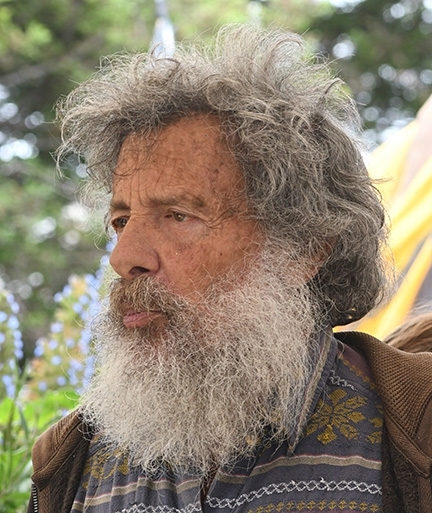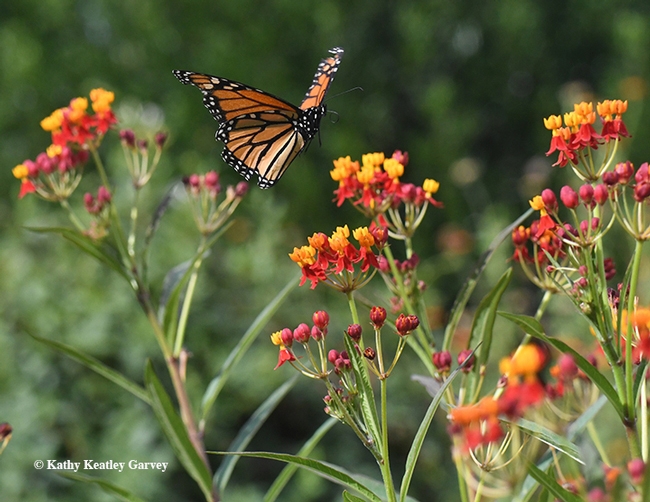
Butterfly guru Art Shapiro, UC Davis distinguished professor of evolution and ecology, spotted a monarch in Sacramento on Wednesday, Jan. 29--way, way, way early to see monarchs in this area.
But it wasn't in his transect.
Shapiro, who maintains a research website at http://butterfly.ucdavis.edu/, has monitored butterfly population trends on a transect across central California since 1972. The 10 sites stretch from the Sacramento River Delta through the Sacramento Valley and Sierra Nevada mountains to the high desert of the Western Great Basin. The largest and oldest database in North America, it was recently cited by British conservation biologist Chris Thomas in a worldwide study of insect biomass.
But back to the monarch sighting.
As Shapiro tells it in his posse email: "We had a visitor today--a British journalist--who wanted to go on a site walk. Rancho Cordova was next up. We went in his rental car. We were on US 50, just passing the Tower Theater in Sacramento heading eastbound, when, at 10.30 a.m. (temperature in mid-upper 50s, light North wind, mostly sunny), a Monarch, sex unknown, flew across the freeway in front of us, 20-22' up, from SW to NE. There is no possibility of error, unless I am having visual hallucinations."
"I have had isolated January records before--mostly not at my sites, though, so I have to extract the data from my data books. The earliest record from a site is ii.1.14 (Feb. 1, 2014) from West Sacramento. All the other pre-March ones are: West Sacramento, ii.22.17, and Rancho Cordova, ii.22.92 and ii.23.06; and Gates Canyon (Vacaville), ii.24.91. In 1992 there were Monarchs in Rancho on iii.3,iii.17 and iii.31, too. 1992 was a drought year."
Later in the afternoon, Shapiro heard monarch Elizabeth Crone, professor of Tufts University, present a UC Davis Department of Entomology and Nematology seminar on the decline of Western monarchs.
In her seminar, Crone expressed concern about the lack of scientific knowledge about monarchs when they emerge from their overwintering sites along coastal California, usually around February, and head inland. Her "main punchline was that we don't know what they're doing between February and when milkweeds break ground later in spring," Shapiro related in his email. "I recommend cruising around in the Coast Range, particularly in Napa and Sonoma counties, looking for them. Of course, this year the total population is so small that the probability of seeing one would be comparable to that on Highway 50 this morning before the fact..."
In a later posse email, Shapiro related that "it turns out we have only one previous January monarch record, and it's from Louie Yang (associate professor, UC Davis Department of Entomology and Nematology), not me, on i.8.2012 in East Davis. There was another record here on ii.19.12. I had one on ii.10.98 in West Davis, near Stonegate. That's it!"
Interestingly enough, Shapiro saw his first monarch of the year before he saw his first cabbage white butterfly of the year! He annually sponsors a contest, "Butterfly for a Beer," or "Suds for a Bug," as part of his research. The first person to collect a live cabbage white butterfly (Pieris rapae) in the three-county area of Sacramento, Yolo and Solano, wins a pitcher of beer or its equivalent. Since 1972, when he launched the contest, the first flight has varied from Jan. 1 to Feb. 22, averaging about Jan. 20. Last year Shapiro collected the contest winner on Jan. 25 near the Suisun Yacht Club, Solano County.
However, as Jan. 29, no sightings and no winner of the 2020 Cabbage White Butterfly Contest.
The score: Monarch, 1, Cabbage White, 0.
(Update: Shapiro sighted a cabbage white butterfly on Jan. 30 at the Putah Creek Nature Park, Winters, Yolo County, but did not collect it. He spotted it basking on a malva leaf at 11:16 a.m., but it took off before he could net it. So, since no collection, no voucher, Shapiro did not declare himself the winner. "Now that I know the bug is out, there's no scientific reason to want more records," he wrote in a posse email. "To be fair to potential competitors, the first person to catch a rapae in the contest area before 5 p.m., Sunday, Feb. 2, wins the beer. I will not try to beat them to a voucher." See rules. Shapiro says this was the latest first flight date for Valley rapae since Jan. 31, 2011.)
Attached Images:
